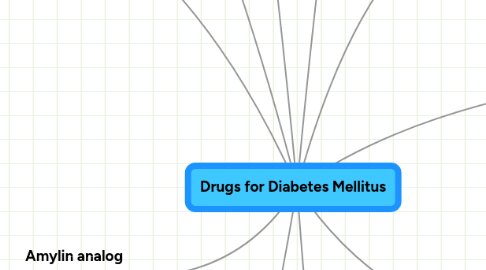
1. Sulfonylureas
1.1. Glimepiride
1.2. Glipizide
1.3. Glyburide
1.4. MOA
1.4.1. Antagonized K channel on pancreatic beta cell
1.4.1.1. Cause cell depolarization and allows efflux of Ca
1.4.1.1.1. Increased insulin release
1.4.2. Increases AMOUNT, not FREQUENCY of pulsatilue release of insulin
1.4.2.1. No effect on basal insulin levels!
1.4.3. Minor effect: Subsequently decreases glucagon release (b/c of increased insulin release)
1.4.3.1. Possibly enhance by increased release of SMSTN w/ insulin
1.5. Use
1.5.1. Type II DM
1.5.2. Take 1/day
1.6. SE
1.6.1. Hypoglycemia
1.6.1.1. Both basal and postprandial
1.6.2. Weight gain
1.6.2.1. d/t high insulin levels
1.6.3. NV
1.6.4. Allergic skin rxns
1.6.5. Cholestatic jaundice
1.6.6. TCP, leukopenia, hemolytic anemia
1.6.7. Hyponatremia and SIADH
2. Meglitinides
2.1. Repaglinide
2.2. Nateglinide
2.3. MOA
2.3.1. Similar to Sulfonylreas
2.3.1.1. binds different site on the K channel
2.4. PK
2.4.1. Fast onset of action (15-30 min)
2.4.2. Short duration of action
2.4.2.1. Repa>Nate
2.4.3. Take before meal to control postprandial glycemia
2.5. Use
2.5.1. Type II DM
2.6. SE
2.6.1. Hypoglycemia
3. Thiazolidinediones (TZDs)
3.1. Pioglitazone
3.2. Rosiglitazone
3.3. MOA
3.3.1. Stimulate PPAR-gamma (intracellular receptor that increases transcription of GLUT-4)
3.3.1.1. Found in fat and some muscle tissue
3.3.2. Increases glucose uptake in M and fat tissue
3.3.3. Decreased levels of free TGs
3.3.4. Inhibit GNG
3.4. Use
3.4.1. Type II D
3.4.2. Taken one/day, with food
3.4.2.1. Requires presence of insulin to work
3.4.2.1.1. GLUT-4 is an insulin sensitive receptor
3.5. SE
3.5.1. Weight gain
3.5.1.1. PPAR activation
3.5.1.1.1. collecting tubules
3.5.1.1.2. Differentiation of pre-adipocytes into mature adipose cells
3.5.2. Fluid retention
3.5.2.1. CI in pts with > Stage III CHF or acutely decompensated
3.5.3. Bone fracture
3.5.3.1. PPAR activated diverts stromal cells from osteoblasts to adipocyte lineage
3.5.3.1.1. fat deposition in bone
3.5.4. Anemia
3.5.5. Hepatotoxicity
3.5.6. Increased risk of CV events
4. Amylin analog
4.1. Primlintide
4.2. Use
4.2.1. Type I & II DM who inject insulin at meal times
4.2.2. SQ injection
4.3. MOA
4.3.1. Released w/ insulin from beta cells
4.3.1.1. Increases satiety
4.3.1.2. Delays gastric emptying
4.3.1.3. Inhibits glucagon release
4.3.2. Reduces postprandial glucose spike
4.4. SE
4.4.1. NVA
4.4.2. Headache
4.4.3. Hypoglycemia when combined w/ insulin
5. Incretin (GLP-1) mimetics
5.1. GLP-1 agonist
5.1.1. Exanatide
5.1.2. Liraglutide
5.1.3. Admin - SQ injection
5.1.4. SE
5.1.4.1. Hypoglycemia
5.1.4.2. Pruritis, urtecaria, rash
5.1.4.3. Acute pancreatitis
5.1.4.4. Lira ONLY - risk of thyroid Ca
5.1.4.4.1. Black box warning!!!
5.2. DPP-IV inhibitors
5.2.1. Sitagliptin
5.2.2. Saxagliptin
5.2.3. Admin - oral
5.2.4. SE
5.2.4.1. Hypoglycemia
5.2.4.2. Allergic rxns
5.2.4.2.1. Stevens-Johnson Syndrome
5.2.4.2.2. angioedema
5.2.4.2.3. anaphyllaxis
5.3. MOA
5.3.1. GLP-1 is secreted by L-cells in ileum
5.3.1.1. Slows gastric emptying in stomach
5.3.1.1.1. Reduces postprandial spike in blood glucose levels
5.3.1.2. Promotes sense of satiety in brain
5.3.1.3. Increases glu-stimulated insulin and decreases glucagon secretion in pancreas
5.3.1.3.1. If target glu-stimulated insulin release, less chance of hypoglycemia
5.3.2. DPP-IV is the NZ that metabolizes GLP-1
5.3.2.1. GLP-1 1/2 life in circulation = 1-2 minutes
5.4. Use
5.4.1. Type II DM
6. Biguanides
6.1. Metformin
6.1.1. Use
6.1.1.1. Reduces insulin resistane in Type II
6.1.1.2. Decreases risk of Type II D in pts with insulin resistance
6.1.1.2.1. Not as effective as lifestyle changes!!!
6.1.2. Admin/PK
6.1.2.1. Ineffective in the absense of insulin
6.1.2.1.1. Must take with food
6.1.2.2. Excreted in urine
6.1.2.3. 1/2 life = 2 hrs
6.1.3. MOA
6.1.3.1. Improves glucose uptake in M and fat celss
6.1.3.2. Reduces hepatic glucose production - Major Action!!!
6.1.3.3. Ultimately decreases serum insulin and glucose levels
6.1.3.3.1. Decreases both fasting and postprandial hyperglycemia
6.1.4. SE
6.1.4.1. Positives
6.1.4.1.1. No risk of hypoglycemia
6.1.4.1.2. Weight loss or stabilization
6.1.4.1.3. Prevent macrovascular complications
6.1.4.1.4. Decreased TG, total and LDL-C
6.1.4.1.5. Cheap!!!
6.1.4.2. Negative
6.1.4.2.1. NVD (pretty common)
6.1.4.2.2. Metallic taste
6.1.4.2.3. Lactic acidosis (rare)
6.1.5. CI
6.1.5.1. Pt predisposed to lactic acidosis
6.1.5.1.1. Renal Dz, Hepatic Dz, or alcoholics
6.1.5.1.2. Hx of LA
6.1.5.1.3. Decreased tissue perfusion or hemodynamic instability
6.1.5.1.4. Discontinue prior to
7. Type II Diabetes causes
7.1. Insulin resistance
7.1.1. Failure of liver to decrease glucose production
7.1.2. Impaired glucose uptake in muscle and fat cells
7.1.3. Drugs that work here:
7.1.3.1. Metformin
7.1.3.2. TZDs
7.2. reduced GLP-1
7.2.1. Drugs that work here:
7.2.1.1. Incretins
7.3. Pancreatic Beta cell dysfuntion
7.3.1. reduced insulin secretion
7.3.1.1. Drugs that work here:
7.3.1.1.1. Sulfonylureas
7.3.1.1.2. Meglitinides
7.3.2. Reduced amylin secretion
7.3.2.1. Drugs that work here:
7.3.2.1.1. Pramlintide
8. Glucagon
8.1. Use
8.1.1. Tx hypoglycemia
8.2. MOA
8.2.1. Made by alpha cells in pancreas; stimulate liver into GNG and glycogenolysis
8.3. Admin
8.3.1. SQ injection
9. Insulin
9.1. Rapid Acting (4 hrs activity)
9.1.1. Insulin Lispro
9.2. Short Acting
9.2.1. Regular Humulin R
9.3. Intermediate Acting
9.3.1. NPH Humulin N
9.4. Long Acting (24 hrs activity)
9.4.1. Insulin Glargine
9.5. Use
9.5.1. Pt often on > 1 type
9.5.1.1. Ex - 1 LA dose/day for basal levels + RA injection before every meal to handle addition carb load
9.5.2. Insulin pump
9.5.2.1. maintains basal raid + gives a meal bolus
9.5.2.2. Only use RA insulin
9.5.3. Injection
9.6. SE
9.6.1. Lipohypertrophy
9.6.1.1. Occurs when you give the injection in the same spot
9.6.2. Hypoglycemia
9.6.2.1. Sx of activated sympathetics
9.6.2.2. Sx of brain not getting enough glucose
10. alpha-glucosidase inhibitors
10.1. Acarbose
10.2. Miglitol
10.3. MOA
10.3.1. Reversible inhibition of NZ on brush border that breaks down disaccharides into glucose
10.3.1.1. Slows absorption of glucose from gut
10.3.1.1.1. Reduces postprand insulin spike
10.3.1.1.2. No effect on fasting glucose levels
10.4. Use
10.4.1. Type II DM
10.4.2. Reduces risk of Type II DM in pts with impaired glucose tolerance
10.5. SE
10.5.1. Flatulence, bloating, abdominal discomfort
10.5.2. Diarrhea
10.5.3. Elevated liver NZs
